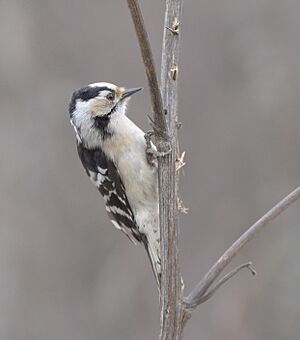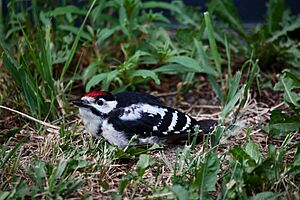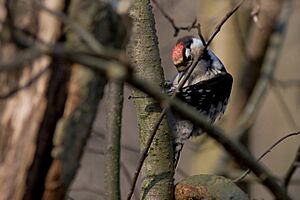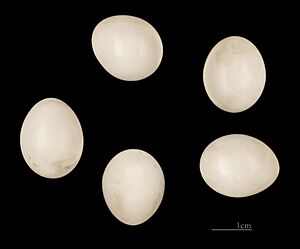Lesser spotted woodpecker facts for kids
Quick facts for kids Lesser spotted woodpecker |
|
|---|---|
 |
|
| Conservation status | |
| Scientific classification | |
 |
|
| Range of D. minor | |
| Synonyms | |
|
The lesser spotted woodpecker (Dryobates minor) is a small bird from the woodpecker family, Picidae. It used to be known by a different scientific name, Dendrocopos minor. This bird lives across a large area called the Palearctic region, which includes Europe, Asia, and parts of North Africa. There are several types, or subspecies, of this woodpecker.
About the Lesser Spotted Woodpecker's Name
Scientists give every living thing a special two-part name. This helps everyone around the world know exactly which animal or plant they are talking about.
The lesser spotted woodpecker was first named by a Swedish scientist named Carl Linnaeus in 1758. He called it Picus minor. Later, in 1816, another scientist moved it to a different group, or genus, called Dendrocopos.
More recently, in 2015, scientists used DNA to study woodpeckers. They found that the lesser spotted woodpecker was actually more closely related to other birds than previously thought. So, its name was changed again to Dryobates minor. The name Dryobates comes from ancient Greek words meaning "woodland walker." The word minor is Latin for "smaller," which fits this little bird!
There are 13 different kinds of lesser spotted woodpeckers, called subspecies, found in various parts of the world:
- D. m. comminutus – Found in England and Wales.
- D. m. minor – Lives in Scandinavia and northeast Poland, stretching to the Ural Mountains.
- D. m. kamtschatkensis – From the Ural Mountains to the Sea of Okhotsk and northern Mongolia.
- D. m. immaculatus – Found in the Anadyr Basin and Kamchatka Peninsula in eastern Siberia.
- D. m. amurensis – Lives in northeast China, Siberia, Korea, and Hokkaido (Japan).
- D. m. hortorum – Found in central Europe.
- D. m. buturlini – Lives in southern Europe.
- D. m. danfordi – Found in Greece and Turkey.
- D. m. colchicus – Lives in the Caucasus and Transcaucasia regions.
- D. m. quadrifasciatus – Found in southeast Azerbaijan.
- D. m. hyrcanus – Lives in northern Iran.
- D. m. morgani – Found in southwest Iran.
- D. m. ledouci – Lives in northwest Africa.
What the Lesser Spotted Woodpecker Looks Like
This is the smallest woodpecker you'll find in Europe! It's about 14 to 16.5 centimeters (5.5 to 6.5 inches) long. Its wings can spread out 24 to 29 centimeters (9.4 to 11.4 inches). It weighs only about 17 to 25 grams (0.6 to 0.9 ounces), which is like weighing a few coins.
Because it's so small and often stays high up in tall trees, this woodpecker can be hard to spot. But if you do see one on a tree trunk, you can tell it apart by the clear black and white stripes on its wings and lower back.
The male lesser spotted woodpecker has a bright red cap on its head. It has a black stripe above its eye and another from its beak to its neck. Its upper back is black, but its lower back has black and white stripes. Its belly is white with some streaks on the sides. Its beak and legs are a grayish color.
The female woodpecker looks similar, but her cap is white instead of red. Young woodpeckers of both sexes might have some red on their heads. Their appearance doesn't change much with the seasons.
Life and Habits
This woodpecker acts a lot like its larger cousin, the great spotted woodpecker. It has a short, almost triangle-shaped body when it flies from tree to tree. Its call is a repeated "keek," which is quite loud for such a small bird. It also makes a fast, vibrating drumming sound. You can hear this drumming often when the birds are looking for mates early in the year.
The lesser spotted woodpecker mainly eats insects. It especially likes larvae that live inside wood. It pecks at rotten wood to find these tasty treats. If you see wood chips at the bottom of a tree, it might mean these birds are looking for insects in the branches above. From autumn to spring, they mostly eat insect larvae found in dead branches. During the breeding season, they also eat more insects found on leaves and tree bark, like aphids. Baby woodpeckers are mostly fed surface insects. At night, these birds sleep in old holes in trees.
When a lesser spotted woodpecker makes a new nest, it digs a hole in a tree. It doesn't always carry away all the wood chips, so you might see them on the ground. The nest hole is usually high up, sometimes 10 to 20 meters (30 to 40 feet) off the ground. The entrance is small, about 2.5 to 5 centimeters (1 to 2 inches) wide. The actual nesting space can be a foot or more below the entrance.
The female usually lays 5 to 8 shiny white eggs in late May. Both parents help to keep the eggs warm until they hatch. Sometimes, they use an old tree hollow instead of digging a new one.
Most lesser spotted woodpeckers stay in the same area, but their numbers can change a lot each year. Cold winters can make it harder for them to survive. Also, spring weather can affect how many insects are available, which then affects how well they can raise their young. Sadly, in the UK, the number of lesser spotted woodpeckers has dropped a lot since 2009. This is partly because people often remove dead trees from parks and woodlands. These dead trees are very important for the woodpeckers because they provide the decaying wood where they like to nest and find food.





